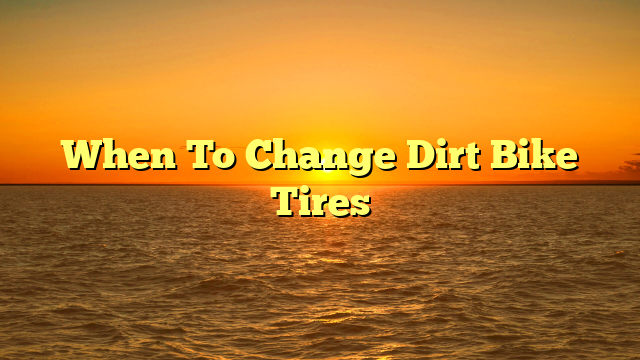As an avid cyclist, I know the importance of maintaining my bike’s components to ensure a smooth and safe ride.
One of the most critical parts of my bike is the tires, which not only affect the bike’s performance but also safety on the road.
Over time, bike tires wear out and need to be replaced.
Knowing when to replace bike tires is vital to prevent accidents and keep your bike in top shape.
In this article, I will share the factors that affect tire wear and tear, how to understand tread depth and wear indicators, and the signs that it’s time to replace your bike tires.
I will also guide you on choosing the right replacement tires for your bike, tire maintenance tips for prolonging lifespan, different types of bike tires and their functions, and how to properly install new bike tires.
So, let’s dive into the world of bike tires and learn when to replace them.
Table of Contents
- 1 Key Takeaways
- 2 Factors that Affect Tire Wear and Tear
- 3 Understanding Tread Depth and Wear Indicators
- 4 Signs that it’s Time to Replace Your Bike Tires
- 5 Choosing the Right Replacement Tires for Your Bike
- 6 Tire Maintenance Tips for Prolonging Lifespan
- 7 Different Types of Bike Tires and Their Functions
- 8 How to Properly Install New Bike Tires
- 9 Frequently Asked Questions
- 9.1 How do I know if my bike tires are safe for use after they have been punctured?
- 9.2 Can I use a different size tire than what came with my bike originally?
- 9.3 Is it necessary to replace both tires at the same time or can I replace just one?
- 9.4 How do I properly dispose of old bike tires?
- 9.5 Are there any eco-friendly options for bike tires?
- 10 Conclusion
Key Takeaways
- Signs it’s time to replace bike tires include worn-down tread and cracks in the rubber
- Worn-out tires can affect the handling and safety of the bike, so it’s important to replace tires every 2,000 to 3,000 miles
- Choosing the right tire for your bike and riding style can improve performance and safety
- Regularly maintaining and replacing bike tires can extend the life of the bike and improve the riding experience.
Factors that Affect Tire Wear and Tear
If you ride your bike frequently on rough terrain or in wet conditions, you’re more likely to experience faster wear and tear on your tires.
This is because the constant friction of the tires against the rough or wet surface can cause the tread to wear down faster than if you were riding on a smooth and dry road.
Additionally, the type of tire you use can also affect how quickly they wear down.
For example, tires with softer rubber compounds might provide better grip and traction, but they’ll also wear down faster than tires with harder compounds.
Causes of uneven wear can also impact the lifespan of your bike tires.
This can occur when the tire pressure is too low or too high, causing the tread to wear down unevenly.
It’s important to regularly check your tire pressure and keep it at the recommended level to ensure even wear and a longer lifespan for your tires.
Neglecting to do so can lead to premature tire wear and the need for a replacement sooner than expected.
Therefore, it’s crucial to keep a close eye on your tires and make sure they’re maintained properly to ensure safe and enjoyable rides.
Understanding Tread Depth and Wear Indicators
You’ll want to keep an eye on how worn down your tire tread is and look for indicators of wear so you can stay safe on the road.
Measuring tread depth is an important aspect of tire maintenance.
As tires wear down, their grip on the road decreases, making it more difficult to stop and steer.
The most common way to measure tread depth is to use a penny.
Place the penny upside down in one of the grooves of the tire.
If you can see the top of Lincoln’s head, it’s time to replace your tires.
Another way to measure tread depth is to use a tread depth gauge.
This tool gives a more precise measurement of the depth of the tread and can help you determine whether your tires need to be replaced.
Interpreting wear patterns is another important aspect of tire maintenance.
Tires can wear unevenly due to improper alignment or over/underinflation.
If you notice that your tires are wearing more on one side than the other, it may be time to have your alignment checked.
Additionally, if you notice that the center of your tires is wearing down faster than the edges, your tires may be overinflated.
Conversely, if the edges of your tires are wearing down faster than the center, your tires may be underinflated.
By monitoring the tread depth and wear patterns of your tires, you can ensure that you’re driving on safe and reliable tires.
Signs that it’s Time to Replace Your Bike Tires
When your bicycle’s tires display unusual wear patterns or have cracks in the rubber, it’s time to start considering purchasing new ones.
Tires are a critical component of your bike, and their longevity and performance are essential to your safety and comfort.
Over time, your tires will naturally wear down, especially if you ride frequently or in harsh conditions.
However, there are several signs that you should be mindful of that indicate it’s time to replace your tires.
One of the most obvious signs that it’s time to replace your bike tires is when the tread depth has worn down to the point where it’s no longer providing adequate traction.
This is particularly important if you ride in wet or slippery conditions, as worn-out tires can cause your bike to slide out from under you.
Additionally, if you notice any cracks or bulges in the rubber, it’s a sign that the tire has become weakened and is at risk of failing.
By paying attention to these warning signs, you can ensure that your bike’s tires are always in optimal condition and that you’re able to ride safely and comfortably.
Choosing the Right Replacement Tires for Your Bike
Finding the perfect set of new rubber for your trusty two-wheeled steed can be like searching for the perfect pair of shoes.
There are many factors to consider when choosing replacement tires, such as tire size, tread pattern, and durability.
However, one of the most important factors to consider is the tire brand.
When comparing tire brands, it’s important to consider factors such as price, performance, and durability.
Some popular brands of bike tires include Continental, Schwalbe, Michelin, and Vittoria.
Each brand offers a variety of tire options, ranging from all-purpose tires to specialized tires for different terrains and weather conditions.
Additionally, it’s important to check the recommended tire pressure for your bike, as different tires may require different pressures for optimal performance.
By taking the time to research and compare different tire brands and pressure recommendations, you can find the perfect replacement tires for your bike and ensure a smooth and safe ride.
| Tire Brand | Price Range | Performance | Durability |
|---|---|---|---|
| Continental | $30-$100 | High | High |
| Schwalbe | $35-$120 | High | High |
| Michelin | $25-$90 | Medium | Medium |
| Vittoria | $30-$110 | High | Medium |
The table above provides a quick comparison of four popular tire brands, including their price range, performance, and durability.
It’s important to note that these are generalizations and that each tire model within a brand may have different characteristics.
When choosing replacement tires, it’s also important to consider your personal riding style and needs.
For example, if you frequently ride in wet or muddy conditions, you may want to choose a tire with a more aggressive tread pattern for better traction.
Overall, taking the time to research and compare tire brands and pressure recommendations can help you make an informed decision and ensure a safe and enjoyable ride.
Tire Maintenance Tips for Prolonging Lifespan
Maintaining your tires properly can help extend their lifespan and ensure a smoother ride.
To make the most out of your bike tires, it’s essential to keep them in good condition.
Here are some tire maintenance tips to help you prolong their lifespan:
- Proper inflation: Keeping your tires inflated to the recommended pressure can prevent punctures and ensure a comfortable ride.
Check your tire pressure regularly, especially before long rides.
- Regular cleaning: Dirt, debris, and small rocks can get stuck in your bike tires, causing damage and affecting their performance.
Give your tires a quick wipe-down after every ride to remove any debris.
- Avoiding rough terrain and storage tips: Riding your bike on rough terrain can cause excessive wear and tear on your tires.
Avoiding sharp objects and potholes can also prevent punctures.
When storing your bike, make sure to keep it in a dry, cool place away from direct sunlight and extreme temperatures.
By following these tire maintenance tips, you can prolong the lifespan of your bike tires and ensure a smoother ride.
Remember to check your tires regularly and address any issues promptly to avoid more significant problems in the future.
Different Types of Bike Tires and Their Functions
To get the most out of your ride, it’s important to understand the different types of bike tires and their functions.
One of the first decisions you’ll need to make is whether to go with tubeless or tubed tires.
Tubeless tires are gaining in popularity because they offer a smoother ride and better puncture protection.
They also tend to be lighter than their tubed counterparts, which can improve overall performance.
However, they do require a special rim and sealant to keep them airtight.
When it comes to choosing tires for different terrain, there are a few things to keep in mind.
For road biking, slick tires with minimal tread are best, as they offer the least resistance and the greatest speed.
For mountain biking, you’ll want to opt for wider, more robust tires with lots of treads.
This will provide better grip and stability on uneven terrain.
If you plan to do a mix of both road and off-road riding, hybrid tires are a good choice.
They offer a balance of speed and durability that works well for a variety of conditions.
How to Properly Install New Bike Tires
Installing new bike tires can be a simple and rewarding process, especially if you follow these easy steps.
Before starting, it is important to have the necessary tools and equipment to ensure a successful installation.
Some of the tools needed for tire installation include tire levers, a bike pump with a pressure gauge, and a wrench for removing the wheel.
Once you have all the tools ready, the first step is to remove the old tire and tube.
Using tire levers, gently pry the bead of the tire away from the rim.
Once the tire is off, remove the tube and check it for any damages.
Next, insert the new tube into the tire and place the tire back onto the rim.
Ensure that the tire is properly aligned and that the bead is securely in place.
Finally, inflate the tire to the proper inflation level, which can be found on the sidewall of the tire, and check the tire pressure before heading out on your ride.
By following these steps and properly checking the tire pressure, you can ensure a safe and efficient ride.
Frequently Asked Questions
How do I know if my bike tires are safe for use after they have been punctured?
To check the durability of my bike tires after a puncture, I examine the damage and assess if it’s repairable.
If so, I use a tire repair kit to fix it.
If not, I replace the tire to ensure safe usage.
Can I use a different size tire than what came with my bike originally?
Using a different tire size than what came with my bike originally can have both pros and cons.
Compatibility issues may arise, affecting performance and safety.
It’s important to consult with a professional before making any changes.
Is it necessary to replace both tires at the same time or can I replace just one?
Replacing just one tire can be cost effective, but it’s important to consider tire longevity.
Mismatched tires can affect handling and stability, leading to safety issues.
It’s recommended to replace both tires at the same time for optimal performance.
How do I properly dispose of old bike tires?
When disposing of old bike tires, I recommend exploring upcycling options such as turning them into planters or using them for DIY projects.
Another option is to look for local recycling programs that accept rubber tires.
Are there any eco-friendly options for bike tires?
Eco-friendly tire alternatives are available, such as those made from natural rubber or recycled materials.
Sustainable tire manufacturing methods include reducing carbon emissions and minimizing waste.
These options promote environmental responsibility and can be considered when purchasing new tires.
Conclusion
In conclusion, replacing bike tires is a crucial aspect of bike maintenance that shouldn’t be overlooked.
Understanding the factors that affect tire wear and tear, such as road conditions and tire pressure, can help you determine when it’s time to replace your tires.
Monitoring tread depth and wear indicators is also important in ensuring your safety while biking.
When it comes to choosing replacement tires, it’s essential to consider your bike’s specific needs and the type of riding you’ll be doing.
Proper tire maintenance, such as maintaining proper tire pressure and avoiding overloading your bike, can also help prolong the lifespan of your tires.
By taking these factors into consideration and properly installing new bike tires, you can enjoy a safer and more comfortable biking experience.







